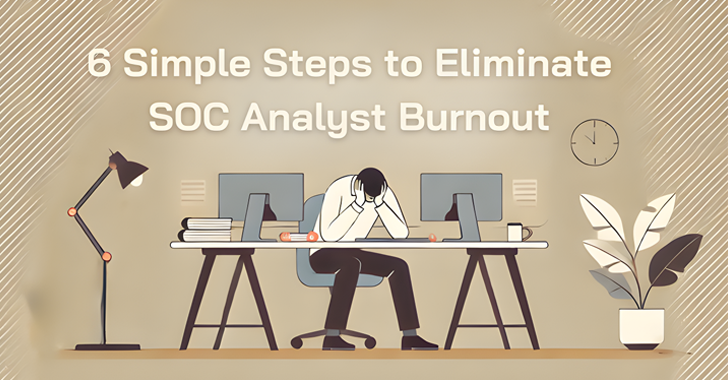The current SOC model relies on a scarce resource: human analysts. These professionals are expensive, in high demand, and increasingly difficult to retain. Their work is not only highly technical and high-risk, but also soul-crushingly repetitive, dealing with a constant flood of alerts and incidents. As a result, SOC analysts often leave in search of better pay, the opportunity to move beyond the SOC into more rewarding roles, or simply to take much-needed breaks. This high churn rate puts the SOC in a vulnerable position, jeopardizing the overall effectiveness of cybersecurity operations.
To keep your team resilient and maintain operational efficiency, it’s essential to take proactive steps to reduce burnout and improve retention. Here are five strategies that can make a difference.
Why Analyst Burnout Matters More Than Ever
SOC analyst burnout is becoming a critical issue as the cybersecurity landscape evolves. Security Operations Centers (SOCs) face a growing number of daily alerts to investigate, with 97% of organizations seeing year-over-year increases in the number of alerts generated, according to the Osterman Research report, “Making the SOC More Efficient,” (October 2024). This surge is overwhelming for analysts, who are responsible for triaging and investigating a flood of data daily.
Compounding this issue is the escalating backlog of unaddressed alerts and incidents. The same report reveals that 89.6% of organizations are experiencing a continuous rise in their security backlogs. As the number of alerts grows, so does the pressure on SOC teams to manage them. Yet, with only 19% of alerts typically addressed, the workload becomes a vicious cycle, leading to unrelenting pressure on the analysts.
This unmanageable workload contributes directly to work-related stress and burnout. Alarmingly, 80.8% of respondents expect this stress to worsen over the next two years if current SOC approaches are not improved. SOCs cannot afford to lose more analysts, yet the cybersecurity talent pool is shrinking. According to the ISC² Workforce Study 2023, there are currently 4 million open cybersecurity roles in the U.S., an 8% year-over-year increase. With 67% of organizations already reporting staff shortages, each analyst’s departure compounds the problem, leading to further strain on those who remain.
Given these challenges, it’s critical to ease the burden on SOC analysts. Automating routine tasks, enabling employee growth, and fostering a healthier work-life balance are essential to prevent burnout. Organizations must invest in their SOC teams now to ensure they can keep up with evolving threats while maintaining a healthy, sustainable workforce.
6 Simple Steps to Eliminate SOC Analyst Burnout:
For a smooth operating SOC, it’s essential that leaders take proactive steps to reduce burnout and improve retention. Fortunately, it’s now easier than ever to implement meaningful changes that positively impact the daily lives of SOC analysts. Here are 6 key steps for reducing analyst burnout:
1. Automate Alert Triage & Investigation
The harsh reality is that there simply aren’t enough human analysts to handle the overwhelming volume of alerts flooding today’s SOCs. This means crucial work often gets filtered out, or worse, left unfinished altogether, increasing the risk of missing critical threats. Every alert needs to be reviewed in order to reduce risk, however SOC automation efforts haven’t been able to fully replicate the nuanced decision-making of human analysts when it comes to triaging and investigating alerts. This has left humans in the driver seat for investigation.
With the recent advancements in agentic AI, we’re seeing a breakthrough in SOC automation. AI is now capable of automating up to 90% of the tier 1 tasks that once bogged down human analysts. This not only ensures that critical alerts are addressed faster but also frees up analysts to focus on more complex, rewarding work. By shifting the tedious, repetitive tasks to AI, organizations can mitigate the risk of missed attacks while offering their human analysts more fulfilling roles that reduce burnout and increase retention.
2. Change the Nature of Analyst Work
A fundamental shift in the SOC model is needed to move analysts from “doing the work” to “reviewing the output of AI.” This transition comes with several significant benefits. First, it eliminates the tedious, repetitive tasks that often lead to burnout, allowing analysts to focus on more strategic decision-making, skill building, and higher value work. Second, it exponentially boosts productivity, as what once took an analyst 40 minutes to complete can now be done in seconds by AI.
The key to making this model successful is leveraging Agentic AI that functions as a true AI SOC analyst. These tools deliver decision-ready results, including a triage verdict, incident scope, root cause analysis, and a detailed action plan. With this comprehensive information at hand, human SOC analysts can quickly grasp the situation, understand how the AI reached its conclusions, and confidently validate the results. From there, they can select the appropriate response actions, drastically reducing manual effort while ensuring swift and accurate incident resolution. This shift not only enhances the effectiveness of the SOC but also improves job satisfaction by allowing analysts to perform more meaningful, high-impact work.
3. Implement Response Automation
Once an incident is validated, the next step—containment and response—is often the most stressful part of the process. It’s time-sensitive and prone to error due to the need to coordinate actions across multiple tools. However, when triage and investigation are handled by AI, the corrective actions become far simpler.
AI SOC analysts can generate detailed response plans that analysts can either execute manually, initiate with a single click, or run automatically without human intervention. This reduces the potential for errors, speeds up response times, and takes the pressure off human analysts during critical moments. By automating these workflows, SOCs can respond more quickly and efficiently to threats while minimizing stress and burnout for their teams.
4. Provide Continuous Training
SOC analysts often bring diverse skill sets shaped by their education and previous roles, but many are eager to advance their careers by sharpening their cybersecurity expertise. Agentic AI offers a unique opportunity for on-the-job training, as it not only automates investigations but also explains its conclusions and provides detailed response plans. This is invaluable because the AI doesn’t just handle the work—it educates analysts along the way by generating incident-specific instructions for containment and remediation.
By working alongside AI, analysts learn best practices for triage, investigation, and response, while also gaining exposure to new tools and methods that they may not have encountered before. It’s like having a mentor embedded in the system, showing them how a more experienced analyst would approach a particular issue. This continuous learning not only helps analysts grow their skills but also prepares them for more senior roles in the future, creating a more capable and satisfied workforce.
5. Enhance Tool Integration
Streamlining workflows is key to reducing the complexity SOC analysts face daily. One powerful approach is leveraging interactive elements like chatbot or co-pilot interfaces, which allow analysts to perform threat hunting and data exploration across multiple security tools from a single interface. Instead of jumping between platforms and manually aggregating information, analysts can ask questions, probe deeper into incidents, and quickly gather insights—all in one place.
This integration not only makes it more efficient to dig deeper into threats, but also helps analysts identify trends, uncover patterns, and gain valuable context without the hassle of navigating multiple tools. With a seamless, unified interface, analysts can focus on understanding and responding to threats faster, improving their productivity and reducing the frustration associated with tool sprawl.
6. Ensure Work-Life Balance
With AI SOC analysts handling the front-line work, there’s far less need for human analysts to work nights, weekends, or holidays to maintain 24/7 coverage. AI can monitor alerts, perform investigations, and even escalate true positives through communication platforms like Slack, Teams, or email. It can ask for approval to take action or run remediation workflows, allowing analysts to manage critical incidents without being pulled into long, tedious investigations during their downtime.
This enables analysts to maintain a healthier work-life balance, knowing they can respond to critical situations quickly from their mobile devices without sacrificing their personal time. By reducing the need for constant on-call availability, AI helps create a more sustainable work environment, minimizing burnout while ensuring that the SOC remains fully operational around the clock.
In today’s demanding cybersecurity environment, SOC analyst burnout is a critical issue that must be addressed for the long-term success of security operations. By implementing AI-driven automation, improving workflows, and fostering a healthy work-life balance, SOCs can create a more efficient and sustainable environment, empowering analysts to thrive while reducing the risk of burnout.
Download this guide to learn more how to make the SOC more efficient, or take an interactive product tour to learn more about AI SOC Analysts.
Found this article interesting? This article is a contributed piece from one of our valued partners. Follow us on Twitter and LinkedIn to read more exclusive content we post.






